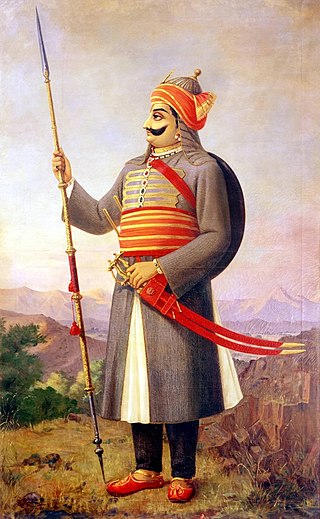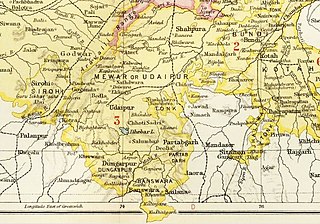Related Research Articles

Pratap Singh I, popularly known as Maharana Pratap, was a king of Mewar, a region in north-western India in the present-day state of Rajasthan. He is notable for leading the Rajput resistance against the expansionist policy of the Mughal Emperor Akbar including the Battle of Haldighati and Battle of Dewair which have turned him into a folk hero.

The Sisodia is an Indian Rajput dynasty belonging to the clan that ruled over the Kingdom of Mewar, in the region of Mewar in Rajasthan. The name of the clan is also transliterated as Sesodia, Shishodia, Sishodia, Shishodya, Sisodya, Sisodiya, Sisodia.

Chittorgarh is a major city in the state of Rajasthan in western India. It lies on the Berach River, a tributary of the Banas, and is the administrative headquarters of Chittorgarh District. It was a major stronghold of the Rajput State of Medapata. The city of Chittorgarh is located on the banks of river Gambhiri and Berach.
Maharana Hammir Singh (1302–1364), or Hammir, was a 14th-century ruler of Mewar in present-day Rajasthan, India. Hammir Singh, was a scion of the cadet branch Rana of the Guhila dynasty, who regained control of the region, re-established the dynasty after defeating the Tughlaq dynasty, and captured present-day Rajasthan from Muslim forces of Delhi and became the first of the 'Rana' branch to become the King of Mewar with title of Maharana. Hammir also became the progenitor of the Sisodia clan, a branch of the Guhila dynasty, to which every succeeding Maharana of Mewar has belonged.

The Chittorgarh, also known as Chittod Fort, is one of the largest forts in India. It is a UNESCO World Heritage Site. The fort was the capital of Mewar and is located in the present-day city of Chittorgarh. It sprawls over a hill 180 m (590.6 ft) in height spread over an area of 280 ha above the plains of the valley drained by the Berach River. The fort covers 65 historic structures, which include four palaces, 19 large temples, 20 large water bodies, 4 memorials and a few victory towers.

The Battle of Haldighati was a battle fought on 18 June 1576 between the Mewar forces led by Maharana Pratap, and the Mughal forces led by Man Singh I of Amber. The Mughals carried the day after inflicting significant casualties on Mewar forces, although they failed to capture Pratap, who reluctantly retreated persuaded by his fellow commanders.
Amet is a town and a municipality located in Rajsamand district in the Indian state of Rajasthan.

The Kingdom of Mewar, sometimes known as Udaipur State, was an independent kingdom in Rajputana region of India, ruled by the Sisodia dynasty. It was established around the 7th century by the minor rulers of the Nagada-Ahar region of Udaipur and later, in the 10th century, it transformed into an independent state under Rawal Bharttripatta II.

Kingdom of Marwar, also known as the Jodhpur State under the British, was a kingdom in the Marwar region from 1243 to 1818 and a princely state under British rule from 1818 to 1947. It was established in Pali by Rao Siha, possibly a migrant Gahadavala noble, in 1243. His successors continued to struggle against regional powers for domination and 9 out of 15 rulers till 1438 died in combat. In 1395, its capital was changed to Mandore by Rao Chunda and to Jodhpur in 1459 by Rao Jodha.

Jag Mandir is a palace built on an island in the Lake Pichola. It is also called the "Lake Garden Palace". The palace is located in Udaipur city in the Indian state of Rajasthan. Its construction is credited to three Maharanas of the Sisodia Rajputs of Mewar kingdom. The construction of the palace was started in 1551 by Maharana Amar Singh, continued by Maharana Karan Singh (1620–1628) and finally completed by Maharana Jagat Singh I (1628–1652). It is named as "Jagat Mandir" in honour of the last named Maharana Jagat Singh. The royal family used the palace as a summer resort and pleasure palace for holding parties. The palace served as a refuge to asylum seekers for one occasion.

Maharana Amar Singh I, the Maharana of Mewar, was the eldest son and successor of Maharana Pratap of Mewar. He was the 14th Rana of Mewar dynasty of Sisodia Rajputs and ruler of Mewar from January 19, 1597 till his death on January 26, 1620. His capital was Udaipur.

Maharana Raj Singh I, was the Maharana of Mewar Kingdom and eldest son of Maharana Jagat Singh I. He fought against Mughal Empire and annexed many Mughal territories He later participated in Rajput War (1679–1707) and defeated Mughals.
Rana Lakha was a king belonging to the Sisodia lineage of Mewar in present-day state of Rajasthan. He was the son of Maharana Kshetra Singh and ruled from 1382 until his death in 1421.

Mokal or Mokal Singh, was the Maharana of Mewar Kingdom.

Panarwa was a thikana of Solanki Rajputs, in the former Mewar State in present-day Rajasthan, India. It was founded c. 1478.
Shakti Singh Sisodia Mewar was the son of Maharana Udai Singh II Sisodia and Rani Sajja Bai Solanki. He was a Kshatriya Rajput and was younger brother of famous Maharana Pratap, He started the Shaktawat clan of Sisodia From his name Rajputs.
The Battle of Rajamahal was a military engagement fought in 1747 in Jaipur, India. The battle was fought between the forces of Sawai Maharaja Ishwari Singh and Maharana Jagat Singh, who wanted to make his nephew Madho Singh the Maharaja of Jaipur or secure a Jagir for him, he built an alliance with the Maratha's under Khanderao Holkar and the Hada clan of Bundi and Kota. The battle resulted in a decisive victory for Ishwari Singh's forces.
Hansa Bai was Rani of the Rajput kingdom of Mewar during the early 15th century. She was the wife of Maharana Lakha Singh and mother to his heir, Mokal.
References
- 1 2 "Rajputana Gazetteers The Mewar Residency Text Vol Ii-a". 13 February 1908 – via Internet Archive.
- ↑ Jafa, Jyoti (10 April 2021). Meera, Sanga and Mewar: The Remarkable Story of A Brave Rajput Princess and Her Legendary Devotion. Roli Books Private Limited. ISBN 978-81-86939-85-7.
- ↑ Tod, Mookerji (1920). Annals And Antiquities Of Rajasthan Vol.3.
- ↑ SINGH, AMIT (19 August 2018). RAJASTHAN POLICE CONSTABLE BHARTI PARIKSHA-2019-Competitive Exam Book 2021 (in Hindi). Prabhat Prakashan. ISBN 978-93-5322-612-1.
- 1 2 "Bhainsrorgarh Fort hotels near Kota, Rajasthan, India". Archived from the original on 4 December 2014. Retrieved 4 December 2014.
- ↑ Page 134, Encyclopaedia of Ancient Indian Geography, Volume 1 By Subodh Kapoor, Publisher Genesis Publishing Pvt Ltd, 2002, ISBN 8177552988, 9788177552980